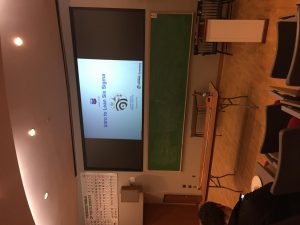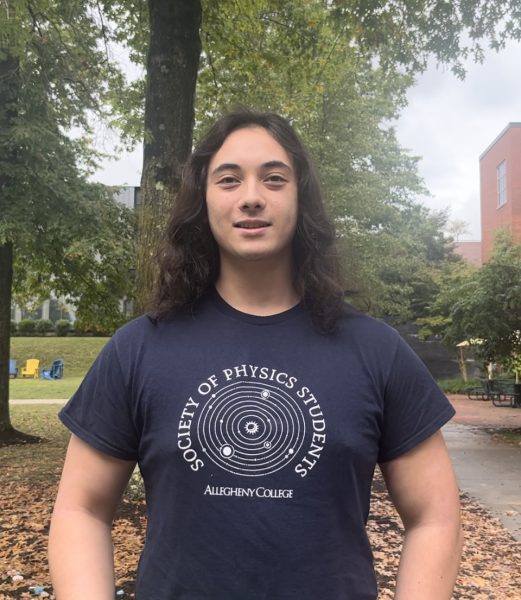Allegheny alumna teaches efficient daily routine
Free pizza drew a crowd of about 70 students to the Quigley Auditorium on Tuesday, Feb. 6 for an afternoon of food and a quick lesson.
Although the aroma of cheese and meat filled the air, the meeting had not been called for the pizza. Lean Six Sigma was preparing to give a short lesson.
The course presenter was Jennifer Rothfuss, an Allegheny alumna who returned to campus to lead a class on Lean Six Sigma.
Rothfuss described Lean Six Sigma as a process created by Toyota and Motorola. The process is used by big corporations around the world to cut their time to complete various tasks by half. As a class at Allegheny college, Lean Six Sigma teaches students how to act in time-efficient and economical ways, according to Rachel Ramsey, ’18, who took the class in the fall of 2017.
“Lean Six Sigma is a how-to. It basically is a program that manufacturers and production facilities use to help their efficiency and reduce their wastes, so it’s something you can become certified in,” Ramsey said. “It was a great class.”
Instead of doing unecessary tasks to get something done, such as sending it to numerous places, they would instead find a way to minimize the amount of time it takes to complete tasks, according to Rothfuss.
Francisco Guzman, ’19, attended the talk and said he enjoyed learning about the program, which he had no prior knowledge of.
“I thought the talk was really interesting, especially because I had no previous knowledge of Lean Six Sigma,” Guzman said. “I was able to obtain the information and understand how relevant it is in the workforce now. It’s pretty much critical problem solving that can be applied in the workforce.”
Rothfuss used several examples, including one of a boy going through his morning routine and travelling to school. For some reason, he could never make it to school on time. She began to break down his routine to see the flaws that could be either fixed or modified to help accelerate the process.
Rothfuss discovered the boy put on his clothes first thing in the morning, and then went to brush his teeth before finally eating breakfast and waiting for the bus.
Instead of this process taking about an hour, it took more than two, because with every task the boy performed, he always dropped at least one thing on his shirt, Rothfuss said. Because of this, he had to keep going back to his room for a new shirt, causing a delay in the morning plans.
Using Lean Six Sigma, Rothfuss showed that by looking deeper at what made the boy late, people would be able to determine how to fix the process.
In this case, instead of the boy getting dressed first and then brushing his teeth and eating, the boy could put his clothes on only after he finished his other tasks, Rothfuss said. The problem would then be solved, since he would be able to change back into his regular clothes and go to school even if his nightclothes were ruined.
By finding the main source of the time hold up, which happened to be the changing of shirts every so often, people would be able to find a way either to go around it or eliminate it as a part of the process.
Rothfuss called two students from the crowd to show how the process works by using a catapult to hit a blue tape box on a table.
At first, they struggled to hit the box at a constant rate, complaining loudly that the catapult had a wide range of motion and made it harder to choose the best place to pull back to in order to hit the box every time.
Later in the presentation, Rothfuss called them back up. She then created limitations for the catapult, such as putting tape on the bottom so it did not move when students threw the ball, or placing a stapler beneath it so it could only be pulled back so far.
After doing all of this, the students noticed that every time, the ball was landing exactly in the blue tape box, instead of falling short.
Again, Lean Six Sigmas process had relieved added stress and effort by minimizing the amount of extra things that could be done in the situation, thereby creating a direct line to the end product.
All of this had a purpose, and Rothfuss explained they had done a small class last year centered around this idea. Only a small number of students attended the two-credit class.
This time, because of the love for the subject, Allegheny is creating a full course worth four credits that is centered around the idea of Lead Six Sigma and will teach the new generation how to implement this idea into jobs, companies and their daily lives.
Anh Ta, ’21, attended the presentation and said Rothfuss was well-spoken.
“I enjoyed it,” Ta said. “I’m considering [taking the class].”
This class will be available next fall, as a full class that will go toward an Economics major.
Although Lean Six Sigma is centered around economical ideals, it is still a very relevant idea to modern society and the everyday lives of normal people.

The Lean Six Sigma presentation, its introduction show on slides, was held in Quigley Hall Auditorium on Tuesday, Feb. 6, 2018.





